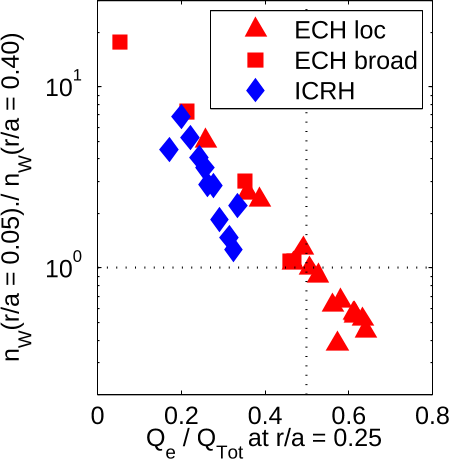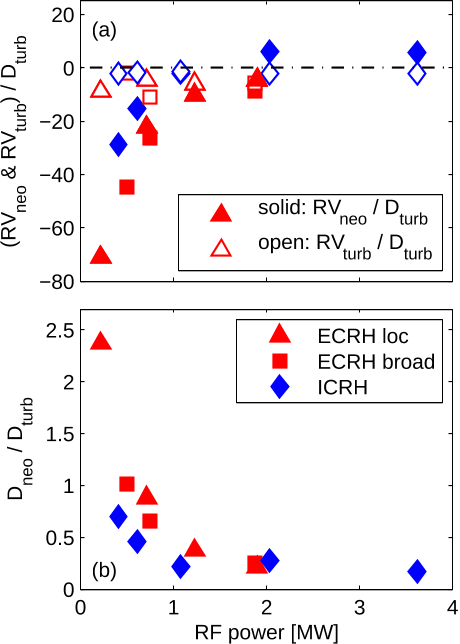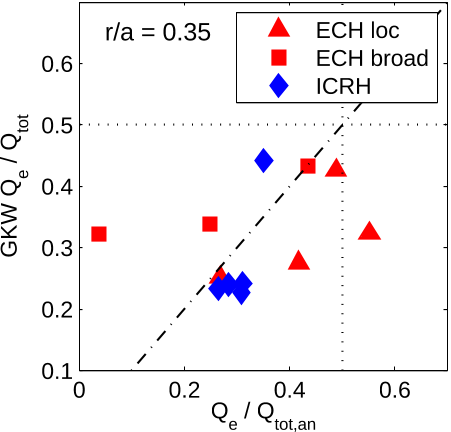
A comparison of the impact of central ECRH and
central ICRH on the tungsten behaviour in ASDEX
Upgrade H-mode plasmas
C. Angioni
1
, M. Sertoli
1
, R. Bilato
1
, V. Bobkov
1
, A. Loarte
2
, R.
Ochoukov
1
, T. Odstrcil
1
, T. P¨utterich
1
, J. Stober
1
and the
ASDEX Upgrade Team
1
Max-Planck Institut f¨ur Plasmaphysik, Garching, Germany
2
ITER Organization, Route de Vinon-sur- Verdon, CS 90 046, 13067 St Paul Lez
Durance, France
Abstract. A comparison of the impact of additional central ele ctron cyclotron
resonance heating (ECRH) and ion cyclotron r e sonance heating (ICRH) on the
behaviour of the tungsten (W) density in the core of H-mode plasmas heated with
neutral beam injection (NBI) is performed in ASDEX Upgrade. Both localized and
broad profiles of the power density of the ECRH have b een obtained, where broa d
profiles reproduce the profile shape of the ICRH power density, which is applied with
a hydrogen minor ity heating scheme. In contrast to ECRH, which produces direct
electron heating only, ICRH eventually hea ts both electrons a nd ions in almost equal
fractions. It is found that both additional RF heating systems re duce the peaking
of the W density pro file with increasing central RF heating power. Approximately
the sa me values of W density peaking are obtained when the same values of electr on
heating are produced by the two RF heating systems, which implies that less total
heating power is required with ECRH than with ICRH to reduce the W density
peaking. A related modelling activity shows that an important ingr e die nt to explain
the e xp erimentally observed trend is the variation of the turbulent W diffusion as a
function of the electron to ion heat flux ratio. Additional effects are connected with the
more favorable W neoclassical transport convection in the presence of ICRH, produced
by the combination of stronger central ion temperature gradients and the impact of
the H minority on the W poloidal density asymmetry.
PACS numbers: 52.55.Fa, 52.25.Fi, 52.25.Vy, 52.65.Tt

A comparison of the impact of central ECRH and central ICRH on the tungsten behaviour in ASDEX Upgr
1. Introduction
Heavy impurities are expected to play a critical role in a fusion reactor plasma, not only
because tungsten (W, Z = 74, A = 184) is currently considered as a first wall material,
but also because highly charged impurities are planned t o be seeded in order to radiate
part of the heating power in the plasma p eriphery and reduce the power loads directly
reaching the walls. Thereby, r obust methods by which the impurity concent ration a nd
the shape of the impurity density profile can be kept under control have to be identified.
These are determined by the combination of the effects of the peripheral sources and the
transport fro m the scrape-off-layer to the plasma core. Central radio frequency (RF)
heating has b een ident ified as a reliable method to limit the central concentration of
heavy impurities [1–9]. Since the behaviour and the profile shapes of heavy impurities
are determined by both turbulent [10–23] and neoclassical transport [25–30], and are also
affected by the presence of magneto-hydrodynamic (MHD) instabilities [6, 31–35], the
physics behind the reduction of the central peaking of the W density produced by central
RF heating can be expected to involve a certain level of complexity, in which multiple
effects are combined. Central RF heating not only modifies the tempera t ur e, density
and rotation profiles of the main plasma, but can also directly modify the impurity
transport. Central accumulation (that is, a W density profile centrally more peaked
than the electron density profile) is produced by the dominance of neoclassical transport
in the unfavourable conditions of inward neoclassical convection (pinch) [1,2,33,36–44].
Turbulent t ransport is not predicted to lead to strong central accumulation (e.g. [13])
and thereby an increase of turbulent impurity transport can offset the neoclassical
pinch. Finally, central RF heating can modify the characteristics of MHD instabilities,
particularly at the q = 1 surface, with impact on the impurity behavior [6, 31, 32, 34].
Here we repo r t the results obtained in an experiment at ASDEX Upgrade ( AUG) in
which plasma discharges have been performed in order to compare the impact of central
electron cyclotron resonance heating (ECRH) and ion cyclotron resonance heating
(ICRH), where the latter is applied with a H–minority heating scheme. D ecreasing
steps of RF heating power have been added to a ba ckground o f neutral beam injection
(NBI) heating power during the current flat–top phase of the plasma discharges, with the
plasma in the H–mode confinement regime. Both localized and broad power deposition
profiles of the ECRH have been produced, where the broad profile reproduces the power
deposition profile shape produced by central ICRH. The experimental results confirm
the beneficial role of cent r al RF heating in reducing the central peaking of the W density,
consistent with previous studies. In addition they allow a direct comparison of the two
RF heating methods and reveal that comparable effects on the W density are produced
when similar amounts of additional electron heating are delivered to the plasma. This
observation implies that, at least in these conditions with a background of large NBI
heating, ECRH is more efficient in reducing the peaking of t he W density, since it
delivers all of the power to the electrons, whereas, with the heating scheme applied in
these experiments, ICRH also has a fr action of the power which heats the ions. The
critical role of electron heating in flattening the central density profile of heavy impurities

A comparison of the impact of central ECRH and central ICRH on the tungsten behaviour in ASDEX Upgr
revealed by these experiments appears to be consistent with previous results at JET [4],
where nickel (Ni) density profiles were observed to be flat with central ICRH in mode
conversion, producing dominant electron heating, and p eaked with central ICRH in He
3
minority heating scheme, producing dominant ion heating, although also with different
power deposition profiles. Moreover, higher values of the cent ral diffusion coefficient of
silicon (Si) were measured in ASDEX Upgrade with central ECRH in comparison to
central ICRH [2], although also in this case the power deposition profiles of ECRH were
more centrally localized than those of ICRH.
In order to identify the transport mechanisms which can explain the new
observations reported in this pap er, power density profiles of ECRH and ICRH have been
computed with the codes TORBEAM [45] and TORIC–SSFPQL [46], and complete
power balance calculations have been obtained with TRANSP [47 ]. In addition,
exp erimentally reconstructed profiles of the W density are compared with the predictions
obtained by combining the results of codes which separately compute neoclassical
and turbulent transport, drift–kinetic NEO [48–50] and gyro–kinetic GKW [51, 52]
respectively. The modelling activity is particularly devoted to identify reasons which can
at least partly explain the observed positive role of electron heating produced by the RF
heating systems. We also note tha t these codes have been run assuming axisymmetric
geometry, that is in the absence of any perturbation of the confining magnetic field
produced by MHD modes.
In Section 2 the experiment is described and the experimental results are presented.
In section 3 the observations are modelled in or der t o shed light on the relative role of
the t r ansport mechanisms governing the W density behaviour. Finally in Section 4
conclusions are drawn.
2. Experimental investigation of the W response to central ECRH and
ICRH
In o rder t o compare the impact of central ECRH and centra l ICRH on W transport in
otherwise similar conditions, plasma discharges of 1 MA and magnetic field around 2.5 T
(q
95
≃ 4) have been produced in ASDEX Upgrade at the line averaged electron density of
n
e
= 7.2 10
19
m
−3
, with the current fla t top phase in the H-mode confinement regime,
heated by 7.5 MW of constant NBI heating power and by decreasing power steps of
central ECRH (from 1.9 MW to 0.2 MW) and ICRH (from 3.6 MW to 0.2 MW). ICRH
is applied with a H-minority heating scheme, with a H concentration around 5%, with
both the 2–straps antenna with boron coated limiters and the 3–straps antenna with
tungsten coated limiters [53]. 3 gyrotrons at 1 40 GHz [54] have been used for ECRH.
Intermediate power steps of ECRH are o bt ained by modulation of the power at the high
frequency of 150 Hz and with 50% duty cycle for each gyrotron. Time traces of two
discharges with decreasing power steps of ICRH and ECRH are presented in Fig. 1 and
Fig. 2 respectively. With decreasing RF power (Figs. 1b and 2b), the W concentration
at the center (Figs. 1c and 2c) (obtained from a fit of the spectrum around 5nm
measured on a single centr al line-o f-sight by the grazing incidence spectrometer ( GIW))

A comparison of the impact of central ECRH and central ICRH on the tungsten behaviour in ASDEX Upgr
0
2
4
6
8
P
NBI
P
rad
[MW]
(a)
0
2
4
[MW]
P
ECH
P
ICRH
(b)
2 4 6 8
10
−5
10
−4
10
−3
ρ ~ 0.1
ρ ~ 0.5
c
W
(c)
0
1
2
[10
20
m
3
]
n
e 20
f
ELM
[100 Hz]
(d)
2 4 6 8
0
1
2
[MJ]
time [s]
β
N
W
MHD
(e)
Figure 1. Time traces of AUG shot ♯324 04 with decreasing steps of ICRH power,
total NBI and radiated powers (a), total ECH and ICRH powers (b), W concentration
c
W
= n
W
/n
e
at ρ ≃ 0.1 and ρ ≃ 0.5 (c), ELM frequency and line averaged density
(d), normalized β and total stored energy (e).
0
2
4
6
8
P
NBI
P
rad
[MW]
(a)
0
1
2
[MW]
P
ECH
(b)
2 4 6 8
10
−5
10
−4
10
−3
ρ ~ 0.1
ρ ~ 0.5
c
W
(c)
0
1
2
[10
20
m
3
]
n
e 20
f
ELM
[100 Hz]
(d)
2 4 6 8
0
1
2
[MJ]
time [s]
β
N
W
MHD
(e)
Figure 2. Time traces of AUG shot ♯32408 with decreasing steps of ECRH p ower,
total NBI and radiated powers (a), total ECH and ICRH powers (b), W concentration
c
W
= n
W
/n
e
at ρ ≃ 0.1 and ρ ≃ 0.5 (c), ELM frequency and line averaged density
(d), normalized β and total stored energy (e).

A comparison of the impact of central ECRH and central ICRH on the tungsten behaviour in ASDEX Upgr
progressively increases, eventually leading to central accumulation, as also shown by the
corresponding fast increase of the total radiated power (Figs. 1a a nd 2a). The level of
gas puff, by which the ELM frequency can be regulated and the W concentration at
the pedestal top can be limited, is kept to low values in these discharges, and sudden
uncontrolled W accumulation is o bserved in the presence of NBI heating only (usual in
ASDEX Upg r ade H-modes at high plasma currents [3]) .
An interesting observation is that, during the power steps with relatively low levels
of RF heating, the W behaviour can reach stationary conditions with a W density profile
which is significantly more peaked than the electron density profile. Thereby, strictly
speaking, W accumulation is observed, but this does not lead to an uncont rolled process
of increasing accumulation, which instead suddenly takes place in conditions of NBI only
heating, as shown for instance in F igs. 1 and 2. This property is illustrated in Fig. 3
where the time evolutions of the flux–surface–averaged W density profiles (reconstructed
by a SXR W density diagnostic [55]) are plotted as a function of normalized minor radius
r/a and time during high (a,d) and low (b,e) a dditional RF power phases of the two
discharges with additional ICRH (a,b) and ECRH (d,f), whose time traces were already
presented in Figs. 1 and 2 respectively. In Fig. 3 (a,b,d,e), the oscillations of the W
density are produced by sawteeth. In Fig. 3 ( c,e), the time averaged W density profiles
are compared to the corresponding electron density profiles. The profiles are nor ma lized
to their values at r/a = 0.4 (that is, all of the normalized profiles cross 1 at r/a = 0.4).
Fig. 3(c,e) demonstrate that in phases with high RF power no accumulation ta kes pla ce,
whereas in phases with low RF power, statio nary conditions are achieved which exhibit
significant W accumulation.
Since in AUG the ICRH power deposition profiles are relatively broad as compared
to the possibilities of the ECRH power, dischar ges with decreasing power steps of ECRH
have been applied with 3 gyrotrons all converging to a deposition close t o the magnetic
axis (ρ
dep
≃ 0.1) as well as with 3 gyrotrons aiming at different radial locations in
order to approximatively reproduce the profile of the deposited power from ICRH (as
obtained by TORIC–SSFPQL [46] simulations applied to a previous similar plasma).
A compar ison of the profiles of the deposited power with localized ECRH, with broad
ECRH, (computed by TORBEAM [45]) as well as with ICRH (computed with TORIC–
SSFPQL [46]) a re presented in Fig. 4. We also observe that, in comparison with the
RF power profiles, the power density and heat flux profiles produced by NBI (computed
with TRANSP [47]) are much broader than the corresponding profiles produced by the
RF heating systems (4 a,b). However, considering the actual levels of the heat fluxes
in MW (4 c), in the central region the NBI heat flux is comparable to that of broad
ECRH at the maximum p ower step (1.9 MW), whereas the ICRH heat flux profile at
the maximum power step of 3 .4 MW is closer to that obtained with localized ECRH at
1.9 MW. In these discharges, in almost the totality of the heating phases, sawteeth are
present, with sawtooth periods of the order of 100 ms a nd sawtooth inversion radius
usually located between r/a = 0.3 and r/a = 0.35. In the analysis we consider pr ofiles
which are averaged over time windows of about 500 ms, which contain multiple sawtooth
cycles and which provide averaged profiles over the sawtooth oscillations. We o bserve


![Figure 4. Power density (a) and integrated power (b,c) profiles with localized and broad ECRH (TORBEAM) [45] and with ICRH (TORIC-SSFPQL) [46] as well as NBI (TRANSP) normalized to the maximum power density in (a) and normalized to the total injected power in (b), in actual MW in (c). In (c) the phases with maximum heating power of ECRH (1.9 MW) and ICRH (3.4 MW) are considered. Different x–axis are used in (a,b) and in (c).](/figures/figure-4-power-density-a-and-integrated-power-b-c-profiles-2stqorh3.png)


